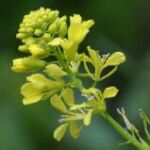| Common Name: |
Brown Mustard |
| Other Names: |
Black Mustard, Red Mustard, Mustard Seed |
| Botanical Name: |
Brassica nigra syn. Sinapsis nigra |
| Genus: |
Brassica |
| Family: |
Brassicacea |
| Native Location: |
Eurasia |
| Cultivation: |
Rich, well-drained, neutral to alkaline soil in full sun. |
| Propagation: |
By seed sown in early spring. |
| Harvest: |
Leaves and flowers are picked when young and used fresh. Pods are harvested as they begin to change color, and dried to complete the ripening process; this prevents the seeds frmo being shed in the field. Seeds store indefinately if kept dry. Volatile oil is distilled from seeds. |
| Height: |
90cm-3m (3-10ft) or more |
| Width: |
90cm-1.2m (3-4ft) |
| Hardiness: |
Hardy |
| Parts Used: |
Leaves and flowers, seeds, oil |
| Properties: |
A pungent, warming herb that stimulates the circulatory and digestive systems, and irritates the skin and mucous membranes. It is a potent emetic in large doses. |
| Medicinal Uses: |
Externally, in poultices, mustard bandages, and baths for rheumatism, muscular pain, chilblains, and respiratory tract infections. A mustard footbath is a traditional remedy for colds and headaches. Skin contact with mustard causes reddening, thus increasing blood flower and removal of toxins. Prolonged contact may result in blistering, especially in those with sensitive skin.
To treat sciatica, bronchial pneumonia, sinusitis, the common cold, rheumatism, and arthritis; in footbaths to treat aching feet. |
| Possible Side Effects: |
Black mustard can cause diarrhea, vomiting, stomach pain, difficulty breathing, and coma. Applied topically, black mustard's side effects include blistering of the skin and skin allergies. |
| Drug Interactions: |
| Taking black mustard with these drugs may interfere with the actions of the drug: |
| Aluminum Hydroxide, (AlternaGel, Alu-Cap) |
Aluminum Hydroxide and Magnesium Carbonate, (Gaviscon Extra Strength, Gaviscon Liquid) |
Aluminum Hydroxide and Magnesium Hydroxide, (Maalox, Rulox) |
Aluminum Hydroxide and Magnesium Trisilicate, (Gaviscon Tablet) |
| Aluminum Hydroxide, Magnesium Hydroxide, and Simethicone, (Maalox, Mylanta Liquid) |
Calcium Carbonate, (Rolaids Extra Strength, Tums) |
Calcium Carbonate and Magnesium Hydroxide, (Mylanta Gelcaps, Rolaids Extra Strength) |
Cimetidine, (Nu-Cimet, Tagamet) |
| Esomeprazole, (Nexium) |
Famotidine, (Apo-Famotidine, Pepcid) |
Famotidine, Calcium Carbonate, and Magnesium Hydroxide, (Pepcid Complete) |
Lansoprazole, (Prevacid) |
| Magaldrate and Simethicone, (Riopan Plus, Riopan Plus Double Strength) |
Magnesium Hydroxide, (Dulcolax Milk of Magnesia, Phillips' Milk of Magnesia) |
Magnesium Sulfate, (Epsom Salts) |
Nizatidine, (Axid, PMS-Nizatidine) |
| Omeprazole, (Losec, Prilosec) |
Pantoprazole, (Pantoloc, Protonix) |
Rabeprazole, (Aciphex, Pariet) |
Ranitidine, (Alti-Ranitidine, Zantac) |
| Sodium Bicarbonate, (Brioschi, Neut) |
Sucralfate, (Carafate, Sulcrate) |
|
| Disease Affects: |
May worsen ulcers in the stomach or small intestines by irritating the lining of the stomach or small intestine. |
| Culinary Uses: |
Young leaves and flowers add pungency to salads. Seeds are ground to make mustard powder or dry mustard, mixed with vinegar as a relish, and used whole in curries, pickles and sausages. |
| Bibliography: |
Encyclopedia of Herbs by Deni Brown Copyright © 1995, 2001 Dorling Kindersley Limited Pp 146-147
The Essential Herb-Drug-Vitamin Interaction Guide by Geo. T. Grossberg, MD and Barry Fox, PhD Copyright © 2007 by Barry Fox, PhD Pp.79-80 |

